Bow Kite Tuning
Kiteboarding Tips
Tip #6 - Bow Kite Tuning Tips
 by Brad Knoth
by Brad Knoth
Well, let me start by stating my bias. For my personal quiver of kites, I have flown nothing but Cabrinha gear since the release of their first kite, the Black Tip, in 2001. While I do make an effort to check out all the gear and ride other stuff when possible, my experience and knowledge base is with the Cabrinha kites. Here is what I am riding currently:
- 9M Crossbow II
- 10M SwitchBlade II
- 12M Crossbow II
- 14M Contra as my big kite
- 128 Cabrinha Imperial Board for high and medium wind
- 148 Cabrinha Prodigy Board for light wind.
- Misc. toys for light wind including a wakesurfer and a skimboard.
Having said that, there are a lot of general principles that apply to most of the bow kites, especially regarding the topic I have been asked to discuss, tuning a bow kite. I have noticed that in the last couple of years, the new kites pretty much come out of the bag tuned and ready to fly. Here are some tuning tips to KEEP your kite flying well:
- Check your line lengths regularly. On most kites (Cabrinha for sure) all four lines should be identical in length; don't tolerate more than a 1/4" variance. On most systems you do this simply by adjusting the knot location on the leader (the leader is the thicker piece of line that the fly lines attach to). The best method for doing this, I have found, is to first adjust your two front lines to make sure they are equal, and then move to adjusting one of the back lines to the length of the fronts. Finally, adjust the other back line to get your bar totally square. I think we can all agree it is no fun to ride with a crooked bar, not to mention it is going to stress one of your elbows.
- Now that you have a true and balanced bar, fly your kite with it at 12 o'clock. Is the bar still totally square? If the bar is crooked then you need to adjust the location of the knot which you attach the back lines to on one side. Is the kite fully powered, but not over-sheeted when you have the bar in to the stop? If the kite is not fully powered, or is over-sheeted when the bar is all the way in, you need to choose a different knot to attach the backlines to. If the kite is over-sheeted and sluggish on turns or backing up at times, move your back lines to the next knot out away from the kite. A quick fix for the session would be to simply pull in a bit of depower to tune the kite. That works, but now you have given up some of your depower range just to get the kite square, so fix your lines ASAP. Just be sure you balance your bar and then your kites. If you follow that order, then you will always have the option to mix and match bars and kites. This is important stuff unless you enjoy frustration, so if it is not quite making sense, seek help.
- For unhooked riding, pulling in a bit of depower to let the trailing edge out a bit makes things a lot more comfortable.
- Keep an eye on your bridles and bridle pulleys. Pulleys can get jammed, and if left that way, the bridle will either wear through the pulley, or the pulley will wear through the bridle.
- On the bow kites, after many hours of use you will eventually see wear in a narrow band on the bridles where the pulleys travel. Keep an eye on this. With the Cabrinha bridles, you can easily take the bridle apart (no tools required) and flip the lines so that the pulley is riding in a different spot. Doing this will double the life of your kite bridles. Bridle replacement kits are available, but for most riders with a normal riding frequency, you should expect a few years without replacement.
Here is a brief overview of doing the swap:
To swap your bridles, simply work the connections loose by hand: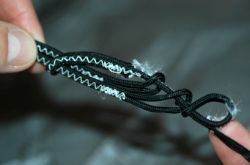
Separate them: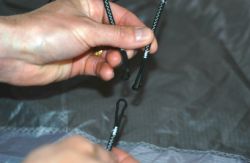
Detach from leading edge: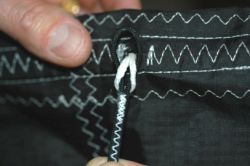
Remove the pulley from the bridle line: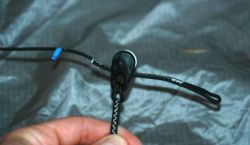
Then just flip flop the bridle line 180 degrees and put everything back together. It can be tricky to get the line back through the pulley, but if you use a piece of fishing line or dental floss to pull the line through while pushing on the other side, you will get it.
If you do for some reason have a pulley that needs to be replaced, it is a simple over-the-counter item that you can get from a lot of places, including Murrays and West Marine. Ronstan #RF13101 for just one, or #RF13101-2 for a pair. They run $9-$11.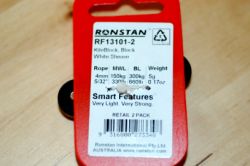
Some of my best bow tips actually have more to do with flying the kite than tuning it. First, in light and/or gusty wind, the kite may race ahead into the wind window in a gust, and then drop back in the lull. A lot of riders tend to keep the bar in tight when this happens with the kite fully sheeted in, which can cause the kite to drop or fall backwards. If this happens, you need to immediately push the bar out and let the kite rise back up.
Secondly, when riding with a relatively small kite for a given wind strength, you need to make your speed and power with apparent wind (wind you create by forward motion and movement of the kite). Sheeting the kite in all the way can, in many cases, kill your apparent wind. When you feel a lull, make a conscious effort to handle the bar lightly and feel the power... don't just automatically pull the bar all the way in thinking that will help; it won't... all you will do is start to stall the kite. That is not the best explanation but if you can play with this and feel it, it will make a ton of sense. Making power and speed with apparent wind will hopefully be covered in detail as a future MACkite tip!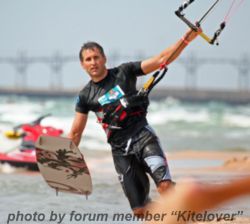
Catch me on the forum (bigair) if I can help with anything at all.
Sincerely,
BK
Rider News & Info
Summer is just around the corner and swim buoys will be in the water.
It's time for the children to play nicely.
Yes, I mean YOU.
We are doing a fantastic job keeping the beaches open so let's keep it up now that the crowds are coming.
Some basics:
- Major beaches are off limits once the summer starts. Holland and Grand Haven will be an accident waiting to happen if people start riding where there are thousands of beachgoers.
- NO RIDING inside swim buoys - I don't care how nice the waves are. Move down the beach to where there are no buoys.
- ALWAYS have someone help land your kite (if possible) when sunbathers are present. No sense in taking a chance of your kite flipping over and going down the beach.
- When walking back up the beach, please fly your kite over the water - it's okay if it gets wet.
It's been great to see everyone on the water.
See you there soon.
Steve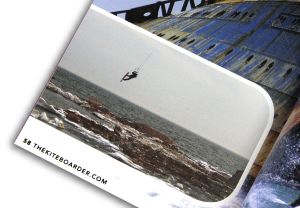
Nice picture of Andy B jumping icebergs in "The Kiteboarder" mag- way to score, Andy!
